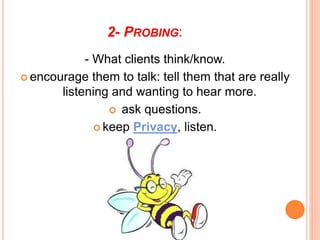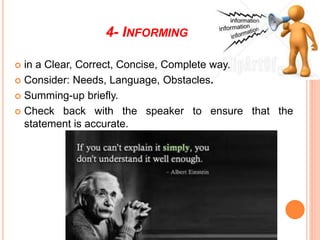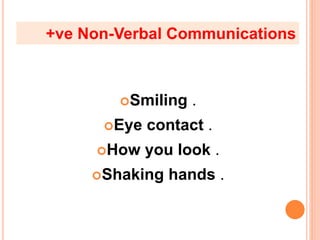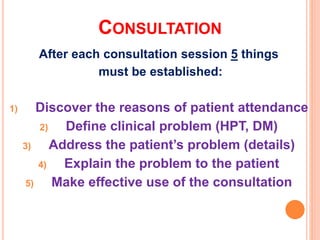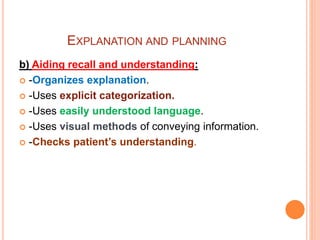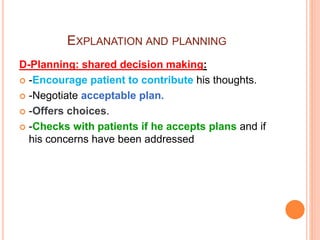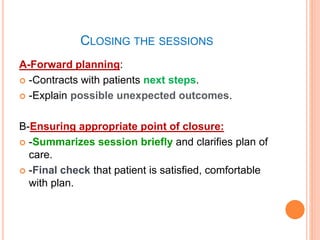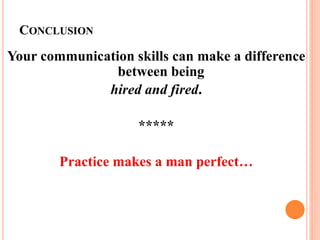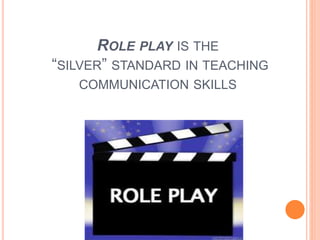Communication skills.
- 2. “We are born to see, but have to train ourselves to observe”
- 3. What (Definition ) Why (Importance ) How (Elements + Principles) By what (Forms) Why not (Barriers )
- 4. WHAT IS COMMUNICATION? Communication is sending or receiving ideas, thoughts or feelings from one person to one or more persons in such a way that, the person receiving it understands it in the same way the sender wants him/her to understand. The term ‘communication’, derived from a Latin term ‘communicare’. • Also known as “people skills” or “soft skills”. • Ranked in a survey as the most important requirement for successful job performance.
- 6. SENDER MESSAGE CHANNEL RECEIVER Context FEEDBACK THE COMMUNICATION PROCESS The person initiating the communication, or broadcasting the message. The specific set of words, gestures and images that the sender uses to convey what he or she wants to say. The channel through which the message moves. Receivers (or the audience for the message) - from whom the receiver often expects a response. The response from the receiver to the sender.
- 10. Effective communication = R (receiver’s meaning) ----------------------------------- = 1 S (sender’s meaning)
- 11. WHY WE STUDY COMMUNICATION SKILLS? 1-History taking: 60% to 80% of diagnosis. 2-Good communication provides information to the patient: -more than 50% of patients deviate from the doctors’ advice or do not follow it at all. 3-Poor quality of communication leads to patient’s dissatisfaction: - Doctors interrupt patients very early. - Patients do not understand what the doctor is saying. - Advice is too difficult to follow.
- 12. COMMUNICATION PRINCIPLES Listening (not HEARING) Probing (encourage) Observing (non- verbal) Informing (4 Cs = Clear, Correct, Concise, Complete)
- 13. 1- LISTENING: Active process (Not hearing), it involves a conscious effort to listen to words; to the way they are said, to be aware of the feelings shown and attempts to hide feelings. You should: Focus your attention; avoid barriers. Show that you are listening (verbally and nonverbally). Understand ideas and pick key words. Retain information (memory, notes). Reflect or give your feedback.
- 15. 2- PROBING: - What clients think/know. encourage them to talk: tell them that are really listening and wanting to hear more. ask questions. keep Privacy, listen.
- 16. 3- OBSERVING: Nonverbal communication through: - Facial expressions, - Voice tone - Body language.
- 17. 4- INFORMING in a Clear, Correct, Concise, Complete way. Consider: Needs, Language, Obstacles. Summing-up briefly. Check back with the speaker to ensure that the statement is accurate.
- 18. “LAG TIME" The gap between the speed of talking and the speed of listening Most individuals speak at the rate of 100-150 words a minute, while they listen at the rate of 450-500 words a minute.
- 19. “LAG TIME" IS TO BE USED TO: In stead of thinking about what to reply to the person, or worse still allowing your mind to wonder on unrelated subjects, "lag time" is to be used to: - Listen to the words being used - Observe the body language - Make note of the repetition of thoughts and words
- 20. RULES FOR COMMUNICATION 1. Ensure it fits the purpose 2. A.B.C: 3. K.I.S.S 4. Deliver information in 3 stages: Accuracy Keep Introduction Brevity It Main body of content Clarity Short Summary Simple
- 21. Change behavior Get action Ensure understanding Persuade Get & give Information COMMUNICATION GOALS
- 23. Environmental barriers: Loud sounds, activities of nearby people, interruptions from others, physical discomfort Physiological barriers: Deafness, blindness, learning disabilities, illness. Language barriers: Different language, specific terminology Personal barriers: Socioeconomic conditions, values and beliefs, previous experience, not valuing themselves, not believing that their health is important. Psychological barriers: Stress, frustration, anger, tiredness, distracted, preoccupied.
- 24. SENDER MESSAGE CHANNEL RECEIVER Context FEEDBACK THE COMMUNICATION PROCESS OR ELEMENTS Knowledge Formulation Language Tone Personality Ambiguity Interest Clearness Confusion Objectivity Noise Accessibility Adaptation Decoding Physiology Personality Preparation Time Selection bias Formulation
- 27. VERBAL COMMUNICATION Organize Thoughts Paint Word Pictures Watch Grammar
- 28. VERBAL COMMUNICATION clear Clarify Listen Encourage Appreciate reassure Don’t Give orders Attack Be aggressive Be ridiculous.
- 30. Non-verbal communication can Reinforces, Complements, Contradicts, Regulates, or Replaces a verbal message.
- 31. CATEGORIES OF NONVERBAL COMMUNICATION: Body movement; way of walking. Posture; way of sitting, standing. Gesture; movements of hands, legs, arms and feet. Facial expressions & eye contact. Space; place of sitting, distance. Touch; shake hands, patting on the back. Time. Personal appearance; clothes, hair, jeweler. Paralanguage; vocal characteristics (pitch, volume, rate and quality), vocal interferences (umm, uhh).
- 33. Smiling . Eye contact . How you look . Shaking hands . +ve Non-Verbal Communications
- 35. > 360 cm 120 – 360 cm 45 – 120 cm 15 – 45 cm
- 36. WHEN YOU INVADE MY SPACE Reactions to an invasion of your space Feel troubled Get defensive Become aggressive
- 41. COUNSELLING Counselling is a process that uses communication skills to help client/patient to reach an informed decision/choice Counselling will provide customized, client-oriented information and negotiate available alternatives to help take a decision based on clear information. Helping a person or a group to develop self-help and self-care abilities.
- 42. CONSULTATION & COUNSELING Consultation: Process of a dialogue that leads to a decision Counseling: Helping a person or a group of people to develop self help
- 43. CONSULTATION After each consultation session 5 things must be established: 1) Discover the reasons of patient attendance 2) Define clinical problem (HPT, DM) 3) Address the patient’s problem (details) 4) Explain the problem to the patient 5) Make effective use of the consultation
- 44. PRINCIPLES FOR GOOD COUNSELLING Treat each client well Interact actively Give the right amount of information Tailor and personalize the information Use and provide memory aids Provide the services that satisfy the client’s expectations. Help clients remember instructions. Confidentiality
- 45. COUNSELING Preparing a counseling session Physical setting Timing Interpersonal space
- 46. 1. Physical setting Privacy: in a quiet, calm & no interruption Proper lightening & temperature. 2. Timing 45-60 minutes
- 47. 3. Interpersonal space 4-9 feet D D P D P P (√) (√) (×)
- 48. COUNSELING, CONSULTATION, COMMUNICATION PROCESS Initiating the session Gathering Information Building Relationship Explanation and Planning Closing the sessions
- 51. BUILDING RELATIONSHIP Using appropriate non verbal behavior: eye contact, posture, demonstrate confidence Develop rapport: accept patient views, feeling, provide support, deals sensitively with disturbing topics Involve the patients: explain rationale, ask permission and explain process during physical examination
- 52. EXPLANATION & PLANNING A- Providing the correct amount and type of information: -Assesses patient’s starting point -Asks patients what other information does you needs and would be helpful. -Give explanation at appropriate time
- 53. EXPLANATION AND PLANNING b) Aiding recall and understanding: -Organizes explanation. -Uses explicit categorization. -Uses easily understood language. -Uses visual methods of conveying information. -Checks patient’s understanding.
- 54. EXPLANATION AND PLANNING C-Achieving a shared understanding: -Provides opportunities to patients to contribute. -Picks up verbal and non-verbal cues. -Elicits patient’s beliefs, reactions and feelings.
- 55. EXPLANATION AND PLANNING D-Planning: shared decision making: -Encourage patient to contribute his thoughts. -Negotiate acceptable plan. -Offers choices. -Checks with patients if he accepts plans and if his concerns have been addressed
- 56. CLOSING THE SESSIONS A-Forward planning: -Contracts with patients next steps. -Explain possible unexpected outcomes. B-Ensuring appropriate point of closure: -Summarizes session briefly and clarifies plan of care. -Final check that patient is satisfied, comfortable with plan.
- 57. THE ELEMENTS OF COUNSELLING G A T H E R Greet Ask Tell Help Explain Return visit
- 58. GREET Give the clients your full attention as soon as you meet them. Be polite, friendly and respectful. Introduce your self and offer them seats. Ask how you can help? Explain what will happen during the visit. Conduct counselling privately
- 59. ASK ABOUT Reasons for coming. Their experience with the health matter that concerns them. Any information needed to complete client records. Ask Clients about themselves and their families as appropriate.
- 60. TELL CLIENT -To decide what choices and decisions. -To express their feelings, needs, wants, & any doubts, concerns or questions. Keep questions open, simple and brief. Look at your client as you speak. Listen actively to what the client says. Show your interest and understanding all the time. Tell the clients about their condition or Choices Help clients understand their possible condition Information should be: Simple, correct and relevant
- 61. HELP CLIENT TO UNDERSTAND Help the clients think about the results of each possible choice. Ask if the client wants anything made clearer, repeat and rephrase information as needed. Check whether the client has made a clear understanding . “What have You understood?” “What have you decided to do?” Wait for the client to answer.
- 62. EXPLAIN WHAT TO DO Give supplies, if appropriate. If the service cannot be given at once, tell the client how, when & where it could be provided. Describe possible side effects and what to do if they occur. Ask the client to repeat instructions. make sure the client remembers & understands. If possible give the client printed materials to take home. Explain when to come back and why
- 63. RETURN VISIT Check if the client is using the Treatment correctly. Ask if the client has any Question or anything to discuss. Consider all concerns seriously. Ask if the client is Satisfied, has there been any problems since last visit??? Help the client handle any Problems. Refer client who need specialized care.
- 64. CONCLUSION Your communication skills can make a difference between being hired and fired. ***** Practice makes a man perfect…
- 65. ROLE MODELING IS THE “GOLD” STANDARD IN TEACHING COMMUNICATION SKILLS
- 66. ROLE PLAY IS THE “SILVER” STANDARD IN TEACHING COMMUNICATION SKILLS
- 67. TAKE HOME MESSAGE To Be a Good Doctor, we Have to Be a GOOD COMUNICATOR














